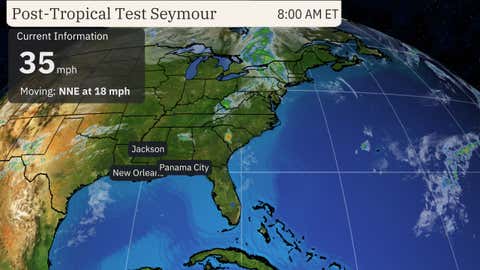HURRICANE CENTRAL
Hurricane Sam Forecast to Become Category 4 in Central Atlantic; Teresa Forms
By weather.com meteorologists
9 hours ago

At a Glance
- Sam became the eighteenth named storm of the 2021 Atlantic hurricane season Thursday.
- It rapidly intensified into the seventh hurricane of the season by Friday morning.
- It will likely intensify into a major hurricane by Saturday.
- It's uncertain whether it will pose a threat to parts of the Leeward Islands, or curl northward.
- It will move slowly, and may not arrive near the Leeward Islands until mid-next week.
Hurricane Sam is intensifying in the central Atlantic Ocean and will soon become a major hurricane. However, it's uncertain whether it will strike the Leeward Islands next week. A new subtropical storm has also formed near Bermuda, but will not have any impacts in the U.S.
Sam became the seventh hurricane of the 2021 Atlantic hurricane season early Friday morning just 24 hours after it was Tropical Depression Eighteen.
Sam is still over 1,000 miles east-southeast of the northern Leeward Islands moving west.
An Uncertain Future For Leeward Islands
Despite Sam's expected rapid intensification, it's not yet clear if Sam will ever threaten land, but it will slow down.

Sam's forward speed will slow this weekend, as high pressure to its north acting as its initial steering wheel weakens.
According to the latest computer forecast models, Sam may not reach the longitude of the Leeward Islands until next Wednesday or Thursday.
Whether it passes over parts of the islands or bypasses them to the north is still unclear, at this time.
Enjoy The Outdoors With This Portable Outdoor Fan (SPONSORED)
Residents in the Leeward Islands should monitor the latest forecast for any possible changes.
Beyond that, the large majority of computer model forecasts eventually curl Sam away from the U.S. East Coast late next week or next weekend.
That's because they're forecasting a weaker, less expansive Bermuda High over the Atlantic Ocean and a stronger trough, or southward plunge of the jet stream, near the East Coast, as described in a previous article here.
That pattern would cause Sam to curl north, then northeastward into the central or western Atlantic Ocean, rather than simply plowing westward.
Sam could at least generate high surf and rip currents along the East Coast more than a week from now even if it stays well offshore, as Hurricane Larry did earlier this month despite passing east of Bermuda.
Sam On the Way to Becoming an Intense Hurricane
Sam is in an environment conducive for intensification into at least this weekend, including low wind shear and increasingly warm water.

In this environment, Sam is expected to become a formidably strong hurricane, at least Category 3, by Saturday.
Beyond that, Sam's environment may become a tad less cooperative.
Fluctuations in intensity due to a replacement of Sam's eyewall beyond this weekend, but Sam is still expected to remain a formidably strong hurricane well into next week.
Sam is a small hurricane with both its tropical-storm-force and hurricane-force winds covering a small area relative to other hurricanes.

Rapid intensification - defined as an increase in maximum winds of at least 35 mph in 24 hours or less - is common in small hurricanes like Sam.
(MORE: Why Some Hurricanes Rapidly Intensify While Others Don't)
Sam became the eighteenth named storm of the 2021 Atlantic hurricane season Thursday, the second earliest "S" storm in Atlantic Basin history, behind only 2020's Sally, according to NHC hurricane specialist Philippe Papin.
Subtropical Storm Teresa Forms
A new storm formed Friday afternoon in the neighborhood of Bermuda and had sustained winds above 40 mph, making it the 19th named storm of the season. It is the second earliest 19th or "T" storm in the basin's history.
Teresa will meander northward in the open Atlantic and is not expected to bring impacts to any land.
Check back with us at weather.com for the latest forecast updates on Sam and Teresa.
The Weather Company’s primary journalistic mission is to report on breaking weather news, the environment and the importance of science to our lives. This story does not necessarily represent the position of our parent company, IBM.

No comments:
Post a Comment